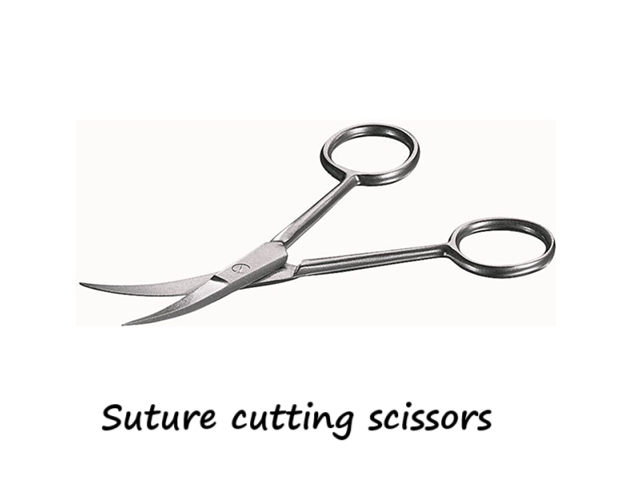In the world of surgery and wound care, precision is everything. From suturing to cutting, every instrument plays a vital role in ensuring successful outcomes. Among these tools, suture cutting scissors are an unsung hero. These specialized scissors are designed to cut sutures cleanly and efficiently without causing damage to surrounding tissues. In this blog post, we’ll explore everything you need to know about suture cutting scissors, including their types, uses, and tips for optimal performance.
What Are Suture Cutting Scissors?
Suture cutting scissors are surgical instruments specifically designed to cut sutures during or after a surgical procedure. They come in various shapes, sizes, and designs to accommodate different types of sutures and surgical needs. These scissors are typically made from high-quality stainless steel, ensuring durability, sharpness, and resistance to corrosion.
Types of Suture Cutting Scissors
- Straight Suture Scissors:
- These scissors have straight blades and are ideal for cutting sutures in easily accessible areas.
- Commonly used in general surgery and wound closure.
- Curved Suture Scissors:
- Featuring curved blades, these scissors provide better visibility and access to hard-to-reach areas.
- Often used in orthopedic, ophthalmic, and deep tissue surgeries.
- Blunt-Tip Suture Scissors:
- Designed with rounded tips to minimize the risk of accidental tissue damage.
- Ideal for cutting sutures near delicate tissues or organs.
- Sharp-Tip Suture Scissors:
- These have pointed tips for precision cutting in tight spaces.
- Commonly used in plastic surgery and fine suturing.
- Hook-Tip Suture Scissors:
- Equipped with a small hook at the tip to lift and cut sutures without damaging underlying tissues.
- Often used in ophthalmic and microsurgical procedures.
- Disposable Suture Scissors:
- Made for single-use to prevent cross-contamination and infection.
- Commonly used in outpatient settings and minor procedures.
Key Features of Suture Cutting Scissors
- Sharp Blades: Designed to cut through sutures cleanly without fraying or pulling.
- Ergonomic Handles: Provide comfort and control during use, reducing hand fatigue.
- Durable Material: Made from high-quality stainless steel for longevity and sterilization compatibility.
- Variety of Sizes: Available in different lengths and blade designs to suit various surgical needs.
Applications of Suture Cutting Scissors
Suture cutting scissors are used in a wide range of medical and surgical procedures, including:
- General Surgery: For cutting sutures during wound closure.
- Orthopedic Surgery: To remove or trim sutures in joint and bone procedures.
- Ophthalmic Surgery: For precise cutting of fine sutures in eye surgeries.
- Plastic Surgery: To ensure clean cuts without damaging delicate tissues.
- Dental Procedures: For cutting sutures in oral surgeries.
- Emergency Care: In trauma cases where quick and efficient suture removal is required.
Advantages of Using Suture Cutting Scissors
- Precision: Designed to cut sutures cleanly without damaging surrounding tissues.
- Versatility: Available in various types to suit different surgical needs.
- Durability: Made from high-quality materials that withstand repeated sterilization.
- Ease of Use: Ergonomic designs ensure comfort and control during procedures.
Tips for Using Suture Cutting Scissors
- Choose the Right Scissors: Select the appropriate type and size of scissors based on the procedure and suture material.
- Inspect Before Use: Ensure the blades are sharp and free of damage to avoid fraying or pulling sutures.
- Handle with Care: Avoid using excessive force, as this can damage the scissors or surrounding tissues.
- Sterilize Properly: Follow proper sterilization protocols to maintain hygiene and prevent infections.
- Store Safely: Keep scissors in a clean, dry place to prevent corrosion or contamination.
Suture Cutting Scissors vs. Regular Scissors
While regular scissors may seem like a convenient alternative, they are not suitable for cutting sutures. Here’s why:
- Precision: Suture cutting scissors are designed for clean, precise cuts, whereas regular scissors may fray or pull sutures.
- Safety: Suture scissors have specialized tips (blunt or sharp) to minimize tissue damage, unlike regular scissors.
- Durability: Surgical scissors are made from high-quality materials that withstand repeated sterilization, unlike regular scissors.
Maintenance and Care
Proper maintenance is essential to ensure the longevity and performance of suture cutting scissors. Here are some tips:
- Clean After Use: Rinse the scissors with distilled water to remove blood or debris.
- Sterilize Regularly: Use autoclaving or chemical sterilization methods to maintain hygiene.
- Inspect for Damage: Check for dull blades or loose hinges and replace or repair as needed.
- Lubricate Moving Parts: Apply a small amount of surgical lubricant to the hinge to ensure smooth operation.
Conclusion
Suture cutting scissors are an indispensable tool in the medical field, offering precision, safety, and efficiency in cutting sutures. Whether you’re a surgeon, nurse, or medical professional, understanding the different types and proper use of these scissors can significantly enhance your practice. By choosing the right scissors and maintaining them properly, you can ensure optimal performance and patient outcomes.
Have you used suture cutting scissors in your practice? Share your experiences or tips in the comments below! If you found this post helpful, don’t forget to share it with your colleagues and friends in the medical field.
Disclaimer: This blog post is for informational purposes only and should not be considered medical advice. Always consult with a qualified healthcare professional for medical guidance.



Leave a Reply